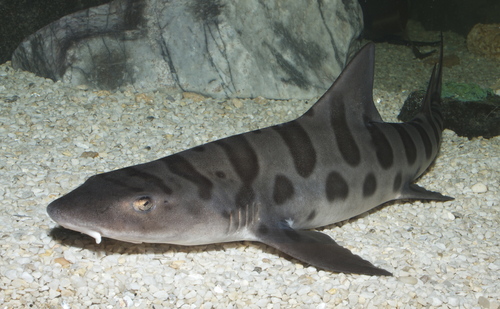
Leopard Shark
The Atlantic bluefin tuna (Thunnus thynnus) is a highly migratory, large pelagic fish renowned for its size, speed, and commercial value. It plays a crucial role in the marine ecosystem and is a top predator.
15 30 years
Lifespan
120 - 210 cm
Length
Least Concern
Conservation Status
N/A km/h
Swimming speed
Carnivorous
Diet
Local Migration, Seasonal Migration
Migration
Appearance Overview
The Atlantic bluefin tuna is a large, torpedo-shaped fish with a metallic blue-black back and a silvery-white underside.
Coloration
Dark metallic blue on top, silvery-white underside
Second dorsal fin
Reddish-brown
Fins
Short pectoral fins
Body shape
Torpedo-shaped and streamlined
Length
Up to 13 feet (4 meters)
Weight
Up to 2,000 lbs (907 kg)
Diet
Carnivorous, feeding on a variety of fish, squid, eels, and crustaceans.
Feeding Behavior
Highly active predator that hunts by sight, often exhibiting opportunistic and cooperative feeding behaviors.
Social Behavior
Forms large schools, especially during migration, but can also be found in smaller groups or solitary.
Commercial Relevance
Highly prized in the sushi and sashimi market, particularly in Japan, fetching very high prices.
Conservation measures
Subject to international fishing quotas, stock assessments, and monitoring programs aimed at sustainable management.
Status
Endangered
Threats
Overfishing, illegal fishing, and bycatch in other fisheries pose significant threats.
Habitat Distribution
Depth Range
0-1,000 meters (0-3,280 feet), with preferences for surface waters.
Geographic Range
Western and eastern Atlantic Ocean, Mediterranean Sea
Preferred Environment
Pelagic, open ocean, preferring temperate waters.
Reproduction and Life Cycle
Breeding Habits
Spawns in the Mediterranean Sea and the Gulf of Mexico, with specific spawning grounds identified.
Development Stages
Eggs hatch into larvae, which develop into juveniles and eventually into mature adults over several years.
Fecundity
Females can release up to 30 million eggs per spawning season.
Maturity Age
Reaches sexual maturity around 4-8 years in the Mediterranean and 8-12 years in the western Atlantic.
Faqs about Leopard Shark
Where can Atlantic bluefin tuna be found?
Atlantic bluefin tuna are found in the western and eastern Atlantic Ocean, as well as the Mediterranean Sea.
How long do Atlantic bluefin tuna live?
They can live up to 40 years.
How fast can Atlantic bluefin tuna swim?
They are among the fastest swimmers in the ocean, capable of bursts of speed up to 43 mph (70 km/h).
Are Atlantic bluefin tuna migratory?
Yes, they are highly migratory, often crossing the entire Atlantic Ocean for feeding and spawning.
What adaptations allow bluefin tuna to swim so fast?
Their streamlined body, retractable fins, and specialized muscle physiology enable high-speed swimming.
Copyright @ Nature Style Limited. All Rights Reserved.
 English
English